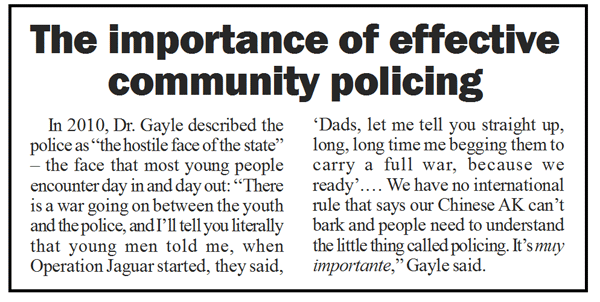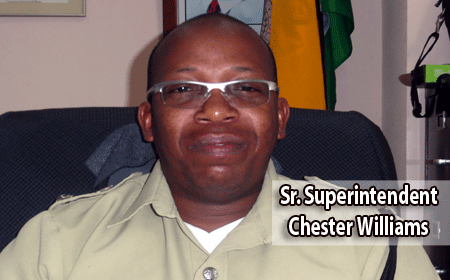BELIZE CITY, Mon. Jan. 4, 2016–In the January 3, 2016 edition of Amandala, Senior Superintendent Chester Williams was honored as our Man of the Year for 2015, in recognition of his remarkable accomplishments during the short time that he has been the Police Department’s Southside Commander: specifically the drastic reduction in the murder rate from 23 in the second half of 2014 to 8 in the second half of 2015—a phenomenal drop of 65%.
On July 7, 2015, Williams was appointed the Police Department’s Commander of the Southside, which encompasses everything south of the four bridges: Chetumal, Belcan, Bel-China, and The Swing Bridge, all the way up to Mile 6 on the George Price Highway, and which is one of three Eastern Division precincts.
In an Amandala exclusive, Williams—a man who came from very humble beginnings, the sixth child born to Isolene Williams, a single mother, who struggled to raise seven of them with the assistance of his grandparents—reflected on his milestone year.
He said that “community policing” has allowed the Police Department to make “significant inroads” in solving and/or preventing crimes where the “big stick approach” has failed.
Multipronged approach targeted at youth breaking the cycle of gun violence
Community engagement key in driving murder rate down in Belize City’s Southside
According to Minister of National Security John Saldivar, community policing has allowed them to focus on crime and the criminal element and also brought the police closer to the community.
Williams said that this multipronged program has featured regular, “Meet and Greet,” sessions, neighborhood watches, family days, the Gang Resistance Education Training Program and the Youth Cadet Program. Williams explained the different aspects of the community policing initiative.
The purpose of the “Meet and Greet” is to bridge the gap between the police and the community. By meeting people on the ground, the police are able to establish trust and alliances are formed to help tackle crime, explained Williams.
Williams further noted that the Neighborhood Watch program is the mechanism which directly involves the community in crime-fighting: There is an elected committee of persons who police their own neighborhood from time to time, he explained.
“We give them different tips that they can use to make their neighborhood safer,” Williams said.
Neighbors are encouraged to be their neighbor’s keeper, and to report any suspicious activity, he added.
The police also organized a series of Family Days with the different gangs, which ran up to September, but Williams hopes the event will resume in 2016, with events to be held every other week.
The fourth prong of the community policing strategy is the Gang Resistance Education Training Program, which entails schools visits and presentations to students from Standard II to Standard VI about the dangers of gang life, while providing them with life training and survival skills.
The fifth facet is the Youth Cadet Core, a program which provides young people with the skills needed to become model Belizean citizens.
According to Douglas Hyde, Coordinator of the Public Relations Unit, Eastern Division, with whom we spoke for further clarification, the community policing strategy also incorporates the fundamentals laid out in the reports of Harold Crooks, the law enforcement professional who did comprehensive work in reviewing the Belize Police Department around 2008, and Jamaican social anthropologist, Dr. Herbert Gayle, who produced the report on Male Social Participation and Violence in Urban Belize in October 2010.
Gayle had specifically advised against, “‘Net fishing’ without proper investigation,” which, he said, “was most criticized by the boys.”

Hyde said that intervention and mediation with the gangs, highlighted in our interview with Williams, has helped to quell retaliatory actions by gang members who would have reacted violently. Instead, mediators are able to get them to talk through their pain while building a greater sense of brotherhood among Southside youth.
Meanwhile, intelligence-gathering by elements of the Gang Suppression Unit and the Special Branch has helped to support the program.
According to Williams, the intervention and mediation efforts have been critical in controlling crime. He acknowledged as well the role played by the GSU in what they do.
Williams is passionate about changing the public image of the Police Department. He frowns upon police brutality and advocates for his staff to be equipped with good public relations skills.
When it comes to deploying cops to the streets, Williams said they try to “strike a balance” by ensuring that the officers are placed in hotspots, without neglecting the other areas.
“In so doing, we try to ensure that we cover as much ground, in order to maintain the peace”, Williams said.
Still there are classic challenges with which he and his team must contend, such as a shortage of vehicles, an enduring impediment to more effective policing—a situation which he hopes would change in 2016.
As noted by Minister Saldivar at the recently held police graduation, the force is over 2,000 strong, but Williams admitted that there is still need for more officers in order to maintain a strong presence on Southside streets.

